Carbothermal Reduction Synthesis of Aluminum Nitride from Al(OH)3/C/PVB Slurries Prepared by Three-Roll Mixing
Abstract
:1. Introduction
2. Experimental
2.1. Experimental Procedure
2.2. Characterization
3. Results and Discussion
3.1. Viscosities of the Slurries
3.2. Tap Densities of Al(OH)3/Carbon Black Powders
3.3. Morphologies of Al(OH)3/Carbon Black Powders
3.4. Phase Compositions of the CRN Products
3.5. Morphologies and Size Distributions of the CRN Products
3.6. The Action Mechanism of PVB in CRN Process
4. Conclusions
Author Contributions
Funding
Institutional Review Board Statement
Informed Consent Statement
Data Availability Statement
Conflicts of Interest
References
- Baik, Y.; Drew, R.A.L. Aluminum nitride: Processing and applications. J. Key Eng. Mater. 1996, 122, 553–570. [Google Scholar] [CrossRef]
- Kudyakova, V.S.; Shishkin, R.A.; Elagin, A.A.; Baranov, M.V.; Beketov, A.R. Aluminium nitride cubic modifications synthesis methods and its features. Review. J. Eur. Ceram. Soc. 2017, 37, 1143–1156. [Google Scholar] [CrossRef]
- Kao, H.L.; Chen, W.C.; Chien, W.C.; Lin, H.F.; Chen, T.C.; Lin, C.Y.; Lin, Y.T.; Chyi, J.I.; Hsu, C.H. Epitaxial AlN thin film surface acoustic wave devices prepared on GaN/sapphire using low-temperature helicon sputtering system. Jpn. J. Appl. Phys. 2018, 47, 124–129. [Google Scholar] [CrossRef]
- Cunha, C.L.A.; Pimenta, T.C.; Fraga, M.A. Growth and properties of sputtered highly (100)-oriented oxygenated AlN thin films for SAW sensing applications. Microsyst. Technol. 2021, 1–10. [Google Scholar] [CrossRef]
- Kim, D.H.; Min, S.J.; Oh, J.M.; Koo, S.M. Fabrication and characterization of oxygenated AlN/4H-SiC heterojunction diodes. Materials 2020, 13, 4335. [Google Scholar] [CrossRef]
- Jackson, T.B.; Virkar, A.; More, K.L.; Dinwideie, R.B.; Cutler, R.A. High-thermal-conductivity aluminum nitride ceramics: The effect of thermodynamic, kinetic, and microstructural factors. J. Am. Ceram. Soc. 1997, 80, 1421–1435. [Google Scholar] [CrossRef]
- Goyal, R.K.; Tiwari, A.N.; Negi, Y.S. High performance polymer/AlN composites for electronic substrate application. Compos. Part B 2013, 47, 70–74. [Google Scholar] [CrossRef]
- Wang, H.Y.; Yuan, Y.; Chi, Z.F.; Yang, Z.Y.; Li, E.Z.; Tang, B. Researches on silane coupling agent treated AlN ceramic powder and fabrication of AlN/PTFE composites for microwave substrate applications. J. Mater. Sci. Mater. Electron. 2019, 30, 20189–20197. [Google Scholar] [CrossRef]
- Chu, A.; Qin, M.; Rafi-ud-din; Jia, B.; Lu, H.; Qu, X. Citric acid-assisted combustion carbothermal synthesis of well-distributed highly sinterable AlN nanopowders. J. Am. Ceram. Soc. 2012, 95, 2510–2515. [Google Scholar] [CrossRef]
- Weimer, A.W.; Cochran, G.A.; Eisman, G.A.; Henley, J.P.; Hook, B.D.; Mills, L.K.; Gutton, T.A.; Knudsen, A.K.; Nicholas, N.R.; Volmering, J.E.; et al. Rapid process for manufacturing aluminum nitride powder. J. Am. Ceram. Soc. 1994, 77, 3–18. [Google Scholar] [CrossRef]
- Baik, Y.; Shanker, K.; Mcdermid, J.R.; Drew, R.A.L. Carbothermal synthesis of aluminum nitride using sucrose. J. Am. Ceram. Soc. 1994, 77, 2165–2172. [Google Scholar] [CrossRef]
- Hu, J.L.; Huang, Q.Z.; Peng, H.X.; Tian, X.Y.; Chen, Z.J.; Peng, Y.X. Effect of reaction conditions on the synthesis of ultrafine AlN powder with glucose as carbon source. J. Ceram. Silik. 2018, 62, 261–273. [Google Scholar] [CrossRef] [Green Version]
- Jung, W.S. Conversion of alumina to aluminum nitride using polymeric carbon nitride as a nitridation reagent. J. Am. Ceram. Soc. 2016, 99, 1520–1524. [Google Scholar] [CrossRef]
- Fu, L.; Qiao, L.; Zheng, J.W.; Ying, Y.; Li, W.C.; Che, S.L.; Yu, J. Phase, microstructure and sintering of aluminum nitride powder by the carbothermal reduction-nitridation process with Y2O3 addition. J. Eur. Ceram. Soc. 2018, 38, 1170–1178. [Google Scholar] [CrossRef]
- Wang, Q.; Ge, Y.Y.; Kuang, J.L.; Jiang, P.; Liu, W.X.; Cao, W.B. Effects of additives on the synthesis of spherical aluminum nitride granules by carbothermal reduction-nitridation process. J. Alloy. Compd. 2017, 696, 220–225. [Google Scholar] [CrossRef]
- Molisani, A.L.; Yoshimura, H.N. Low-temperature synthesis of AlN powder with multicomponent additive systems by carbothermal reduction–nitridation method. J. Mater. Res. Bull. 2010, 45, 733–738. [Google Scholar] [CrossRef]
- Wang, Q.; Cao, W.B.; Kuang, J.L.; Jiang, P. Spherical AlN particles synthesized by the carbothermal method: Effects of reaction parameters and growth mechanism. J. Ceram. Int. 2018, 44, 4829–4834. [Google Scholar] [CrossRef]
- Wan, J.; Qiao, X.S.; Wu, L.A.; Wu, Y.M.; Fan, X.P. Facile synthesis of monodisperse aluminum nitride microspheres. J. Sol-Gel Sci. Technol. 2015, 76, 658–665. [Google Scholar] [CrossRef]
- Lefort, P.; Billy, M. Mechanism of AlN Formation through the Carbothermal Reduction of Al2O3 in a Flowing N2 Atmosphere. J. Am. Ceram. Soc. 1993, 76, 2295–2299. [Google Scholar] [CrossRef]
- Cho, Y.W.; Charles, J.A. Synthesis of nitrogen ceramic powders by carbothermal reduction and nitridation part 3: Aluminum nitride. J. Mater. Sci. Technol. 1991, 7, 495–504. [Google Scholar] [CrossRef]
- Tseng, W.H.; Lin, C.I. Carbothermal reduction and nitridation of aluminum hydroxide. J. Mater. Sci. 1996, 31, 3559–3565. [Google Scholar] [CrossRef]
- Mitomo, M.; Yoshioka, Y. Preparation of Si3N4 and AlN powders from alkoxidederived oxides by carbothermal reaction and nitridation. J. Adv. Ceram. Mater. 1987, 2, 253–256. [Google Scholar] [CrossRef]
- Tsuge, A.; Inoue, H.; Kasori, M.; Shinozaki, K. Raw material effect on AlN powder synthesis from Al2O3 carbothermal reduction. J. Mater. Sci. 1990, 25, 2359–2361. [Google Scholar] [CrossRef]
- Raza, M.A.; Westwood, A.V.K.; Brown, A.P.; Stirling, C. Texture, transport and mechanical properties of graphite nanoplatelet/silicone composites produced by three roll mill. J. Compos. Sci. Technol. 2012, 72, 467–475. [Google Scholar] [CrossRef]
- He, Q.; Zhou, Y.J.; Wang, G.F.; Zheng, B.; Qi, M.; Li, X.J.; Kong, L.H. Effects of two nano-ZnO processing technologies on the properties of rubber. J. Appl. Nanosci. 2018, 8, 2009–2020. [Google Scholar] [CrossRef]
- Qin, X.X.; Cheng, Z.L. Application of ionic liquids as a catalyst in the synthesis of polyvinyl butyral (PVB) polymer. Chin. Chem. Lett. 2016, 27, 145–148. [Google Scholar] [CrossRef]
- Song, X.L.; Song, Y.; Wang, J.; Liu, Q.; Duan, Z.X. Insights into the pore-forming effect of polyvinyl butyral (PVB) as the polymer template to synthesize mesoporous alumina nanofibers via electrospinning. Ceram. Int. 2020, 46, 9952–9956. [Google Scholar] [CrossRef]
- Liau, L.C.K.; Hsieh, Y.P.; Liau, J.Y. Kinetic effects of glass ceramic and silver on poly(vinyl butyral) thermal degradation using FT-IR. 2. Ind. Eng. Chem. Res. 2004, 43, 7780–7784. [Google Scholar] [CrossRef]


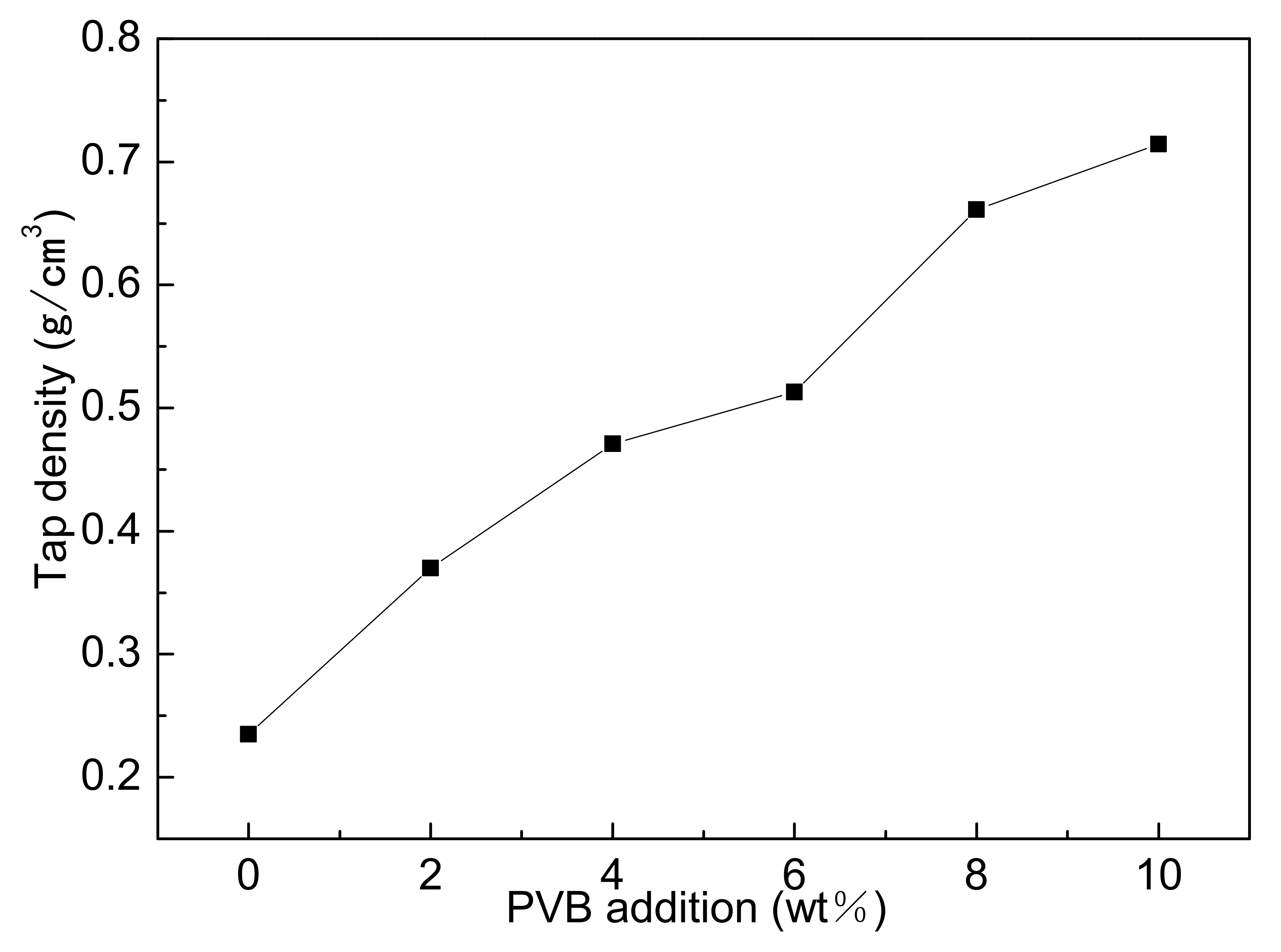
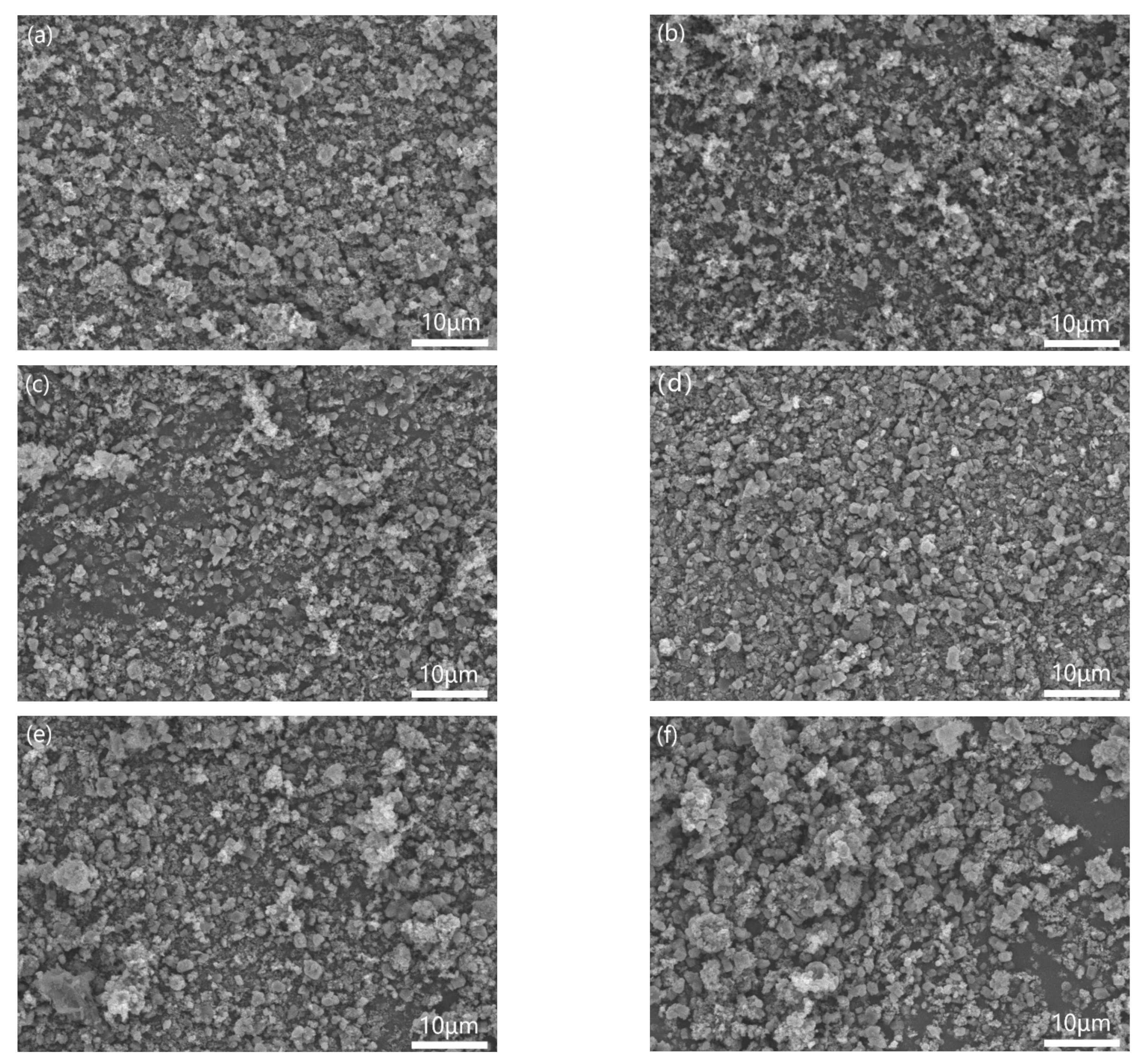
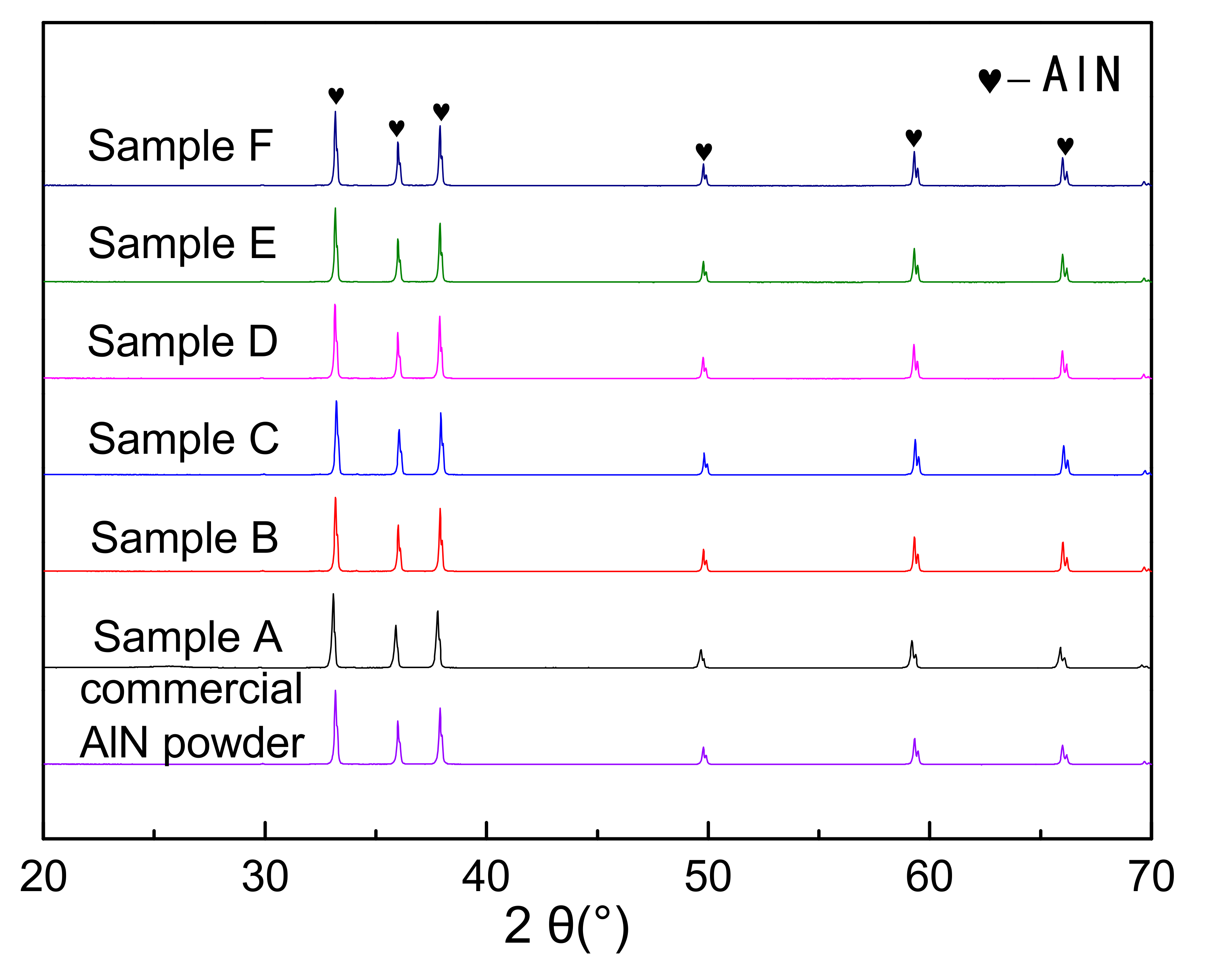
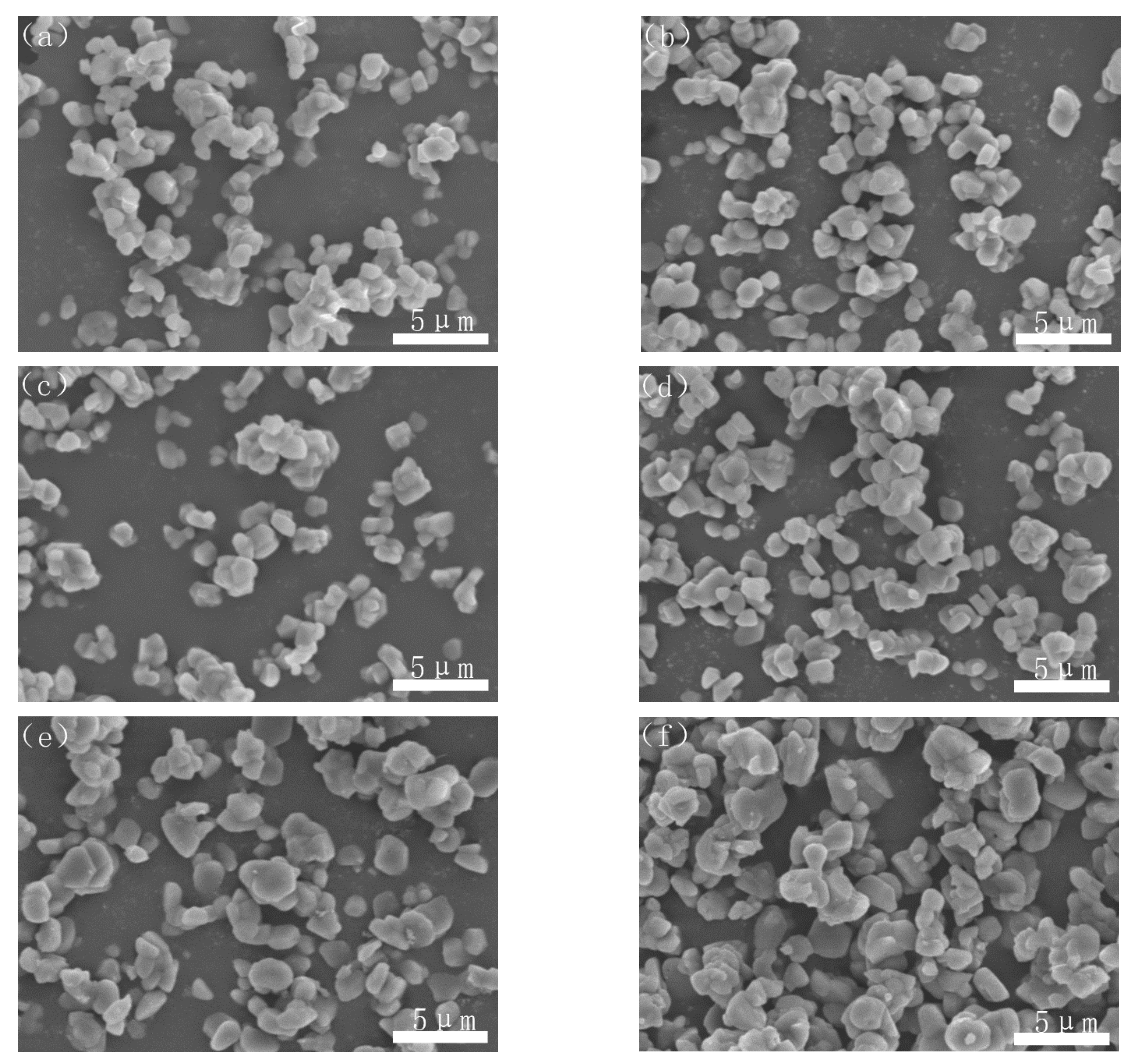
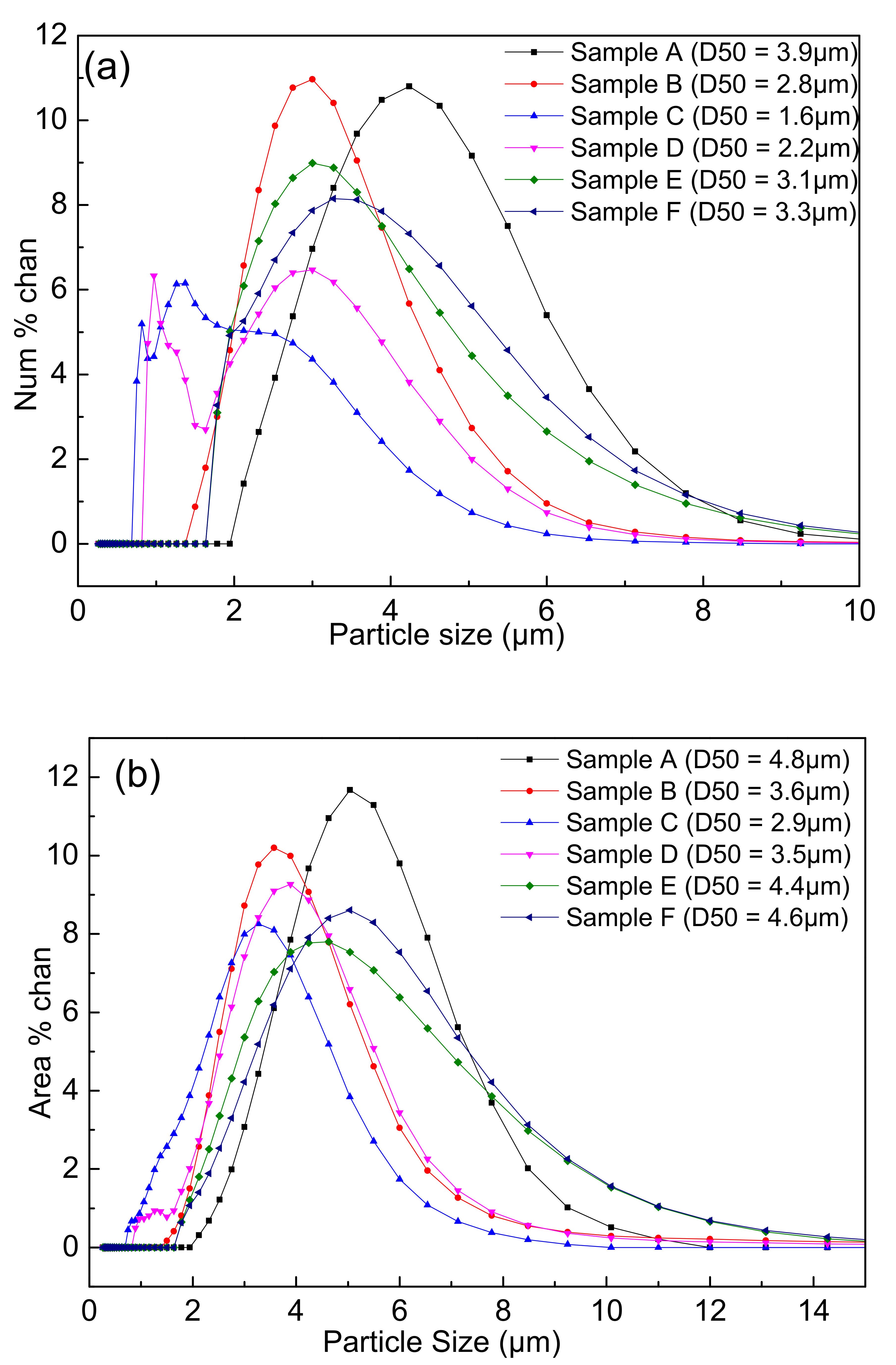
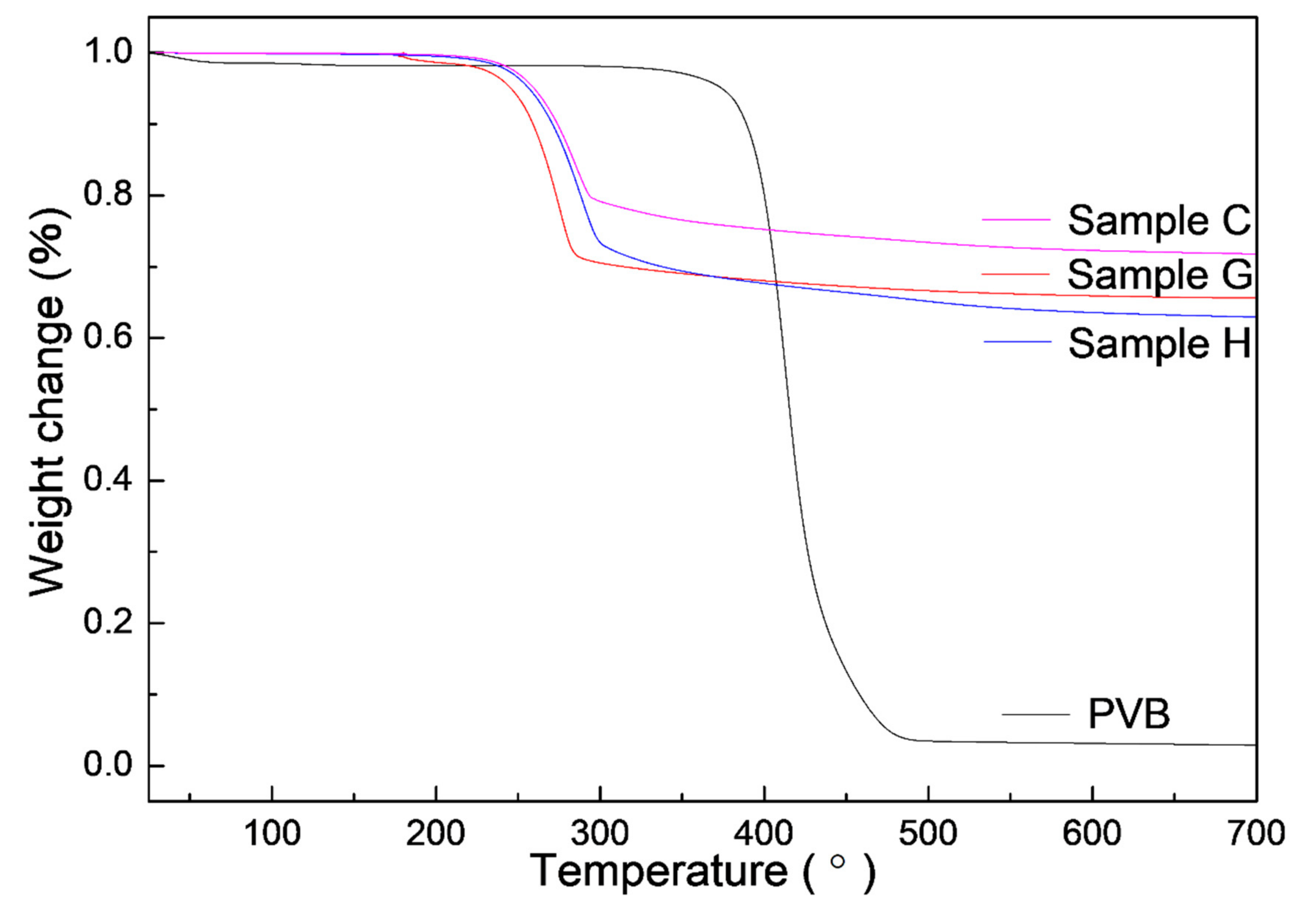
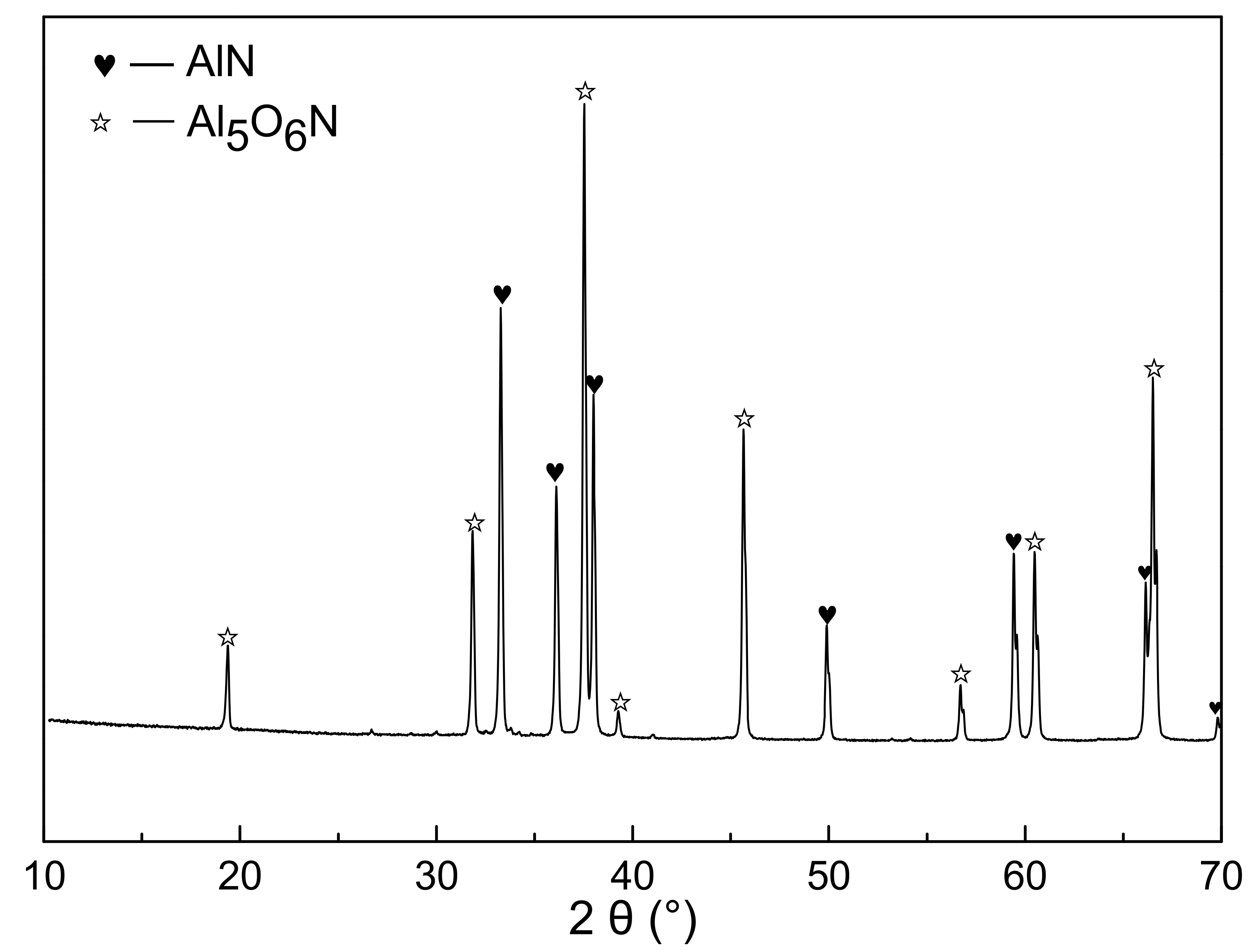
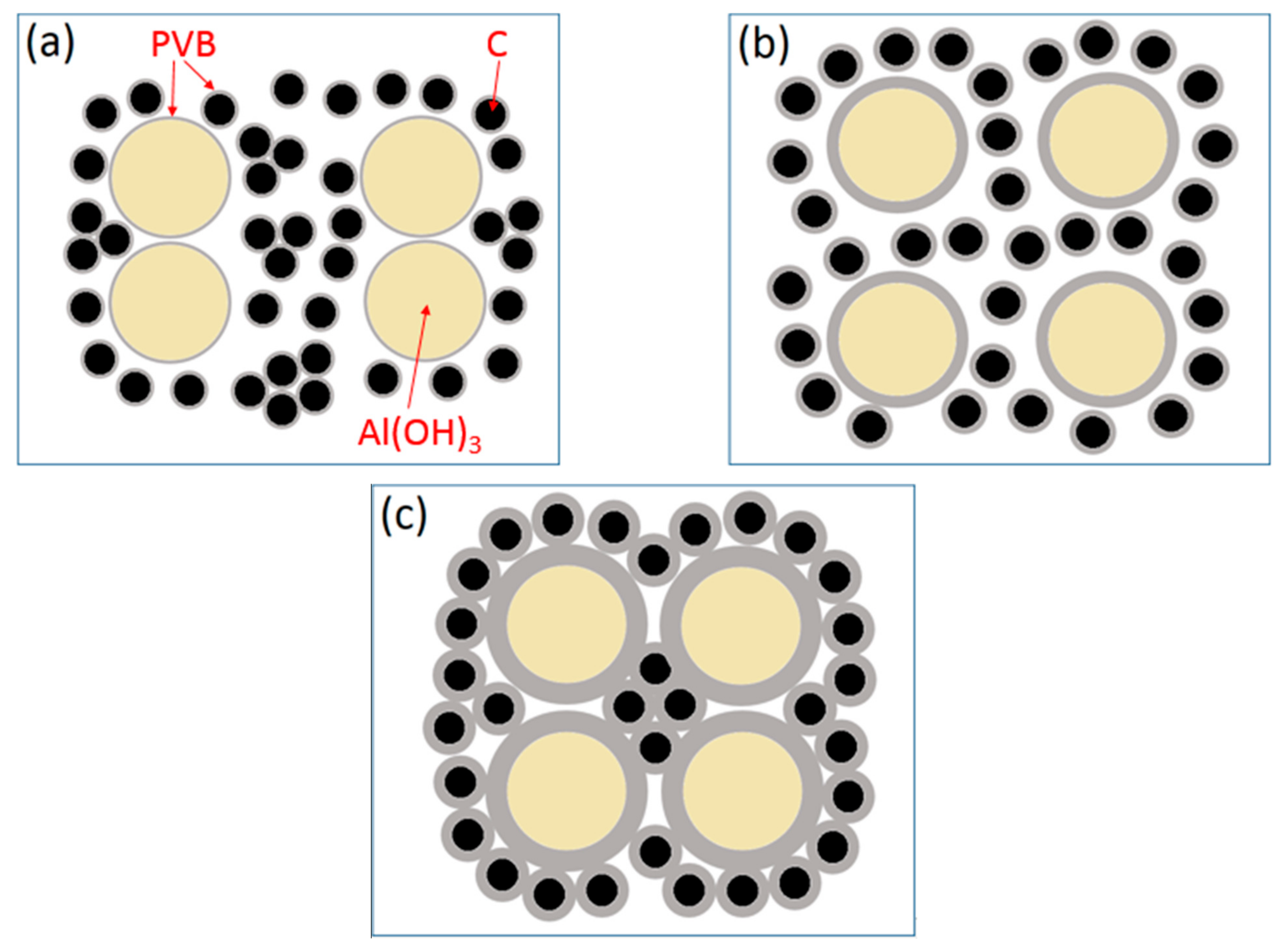
| Sample | Al(OH)3 (g) | Carbon (g) | PVB (g) | m(PVB)/m(Al(OH)3+Carbon) (wt. Ratio) |
|---|---|---|---|---|
| A | 15 | 5 | 0 | 0 |
| B | 15 | 5 | 0.4 | 0.020 |
| C | 15 | 5 | 0.8 | 0.040 |
| D | 15 | 5 | 1.2 | 0.060 |
| E | 15 | 5 | 1.6 | 0.080 |
| F | 15 | 5 | 2.0 | 0.100 |
| G | 15 | 0 | 0 | 0 |
| H | 15 | 0 | 0.8 | 0.053 |
| I | 15 | 0 | 6 | 0.400 |
| T (°C) | PVB | Sample G | Sample H | Sample C | ||
|---|---|---|---|---|---|---|
| i | ii | i | ii | |||
| 25–200 | −1.759 | −1.336 | −0.477 | −1.357 | −0.288 | −1.031 |
| 200–300 | −0.031 | −28.131 | −26.118 | −26.708 | −20.544 | −20.288 |
| 300–486 | −94.393 | −3.753 | −7.903 | −8.342 | −5.514 | −6.337 |
| 486–700 | −0.925 | −1.170 | −2.569 | −1.158 | −1.865 | −0.879 |
| 25–700 | −97.108 | −34.39 | −37.067 | −37.565 | −28.211 | −28.535 |
Publisher’s Note: MDPI stays neutral with regard to jurisdictional claims in published maps and institutional affiliations. |
© 2021 by the authors. Licensee MDPI, Basel, Switzerland. This article is an open access article distributed under the terms and conditions of the Creative Commons Attribution (CC BY) license (http://creativecommons.org/licenses/by/4.0/).
Share and Cite
Wen, Q.; Wang, P.; Zheng, J.; Ying, Y.; Yu, J.; Li, W.; Che, S.; Qiao, L. Carbothermal Reduction Synthesis of Aluminum Nitride from Al(OH)3/C/PVB Slurries Prepared by Three-Roll Mixing. Materials 2021, 14, 1386. https://doi.org/10.3390/ma14061386
Wen Q, Wang P, Zheng J, Ying Y, Yu J, Li W, Che S, Qiao L. Carbothermal Reduction Synthesis of Aluminum Nitride from Al(OH)3/C/PVB Slurries Prepared by Three-Roll Mixing. Materials. 2021; 14(6):1386. https://doi.org/10.3390/ma14061386
Chicago/Turabian StyleWen, Qian, Peng Wang, Jingwu Zheng, Yao Ying, Jing Yu, Wangchang Li, Shenglei Che, and Liang Qiao. 2021. "Carbothermal Reduction Synthesis of Aluminum Nitride from Al(OH)3/C/PVB Slurries Prepared by Three-Roll Mixing" Materials 14, no. 6: 1386. https://doi.org/10.3390/ma14061386
APA StyleWen, Q., Wang, P., Zheng, J., Ying, Y., Yu, J., Li, W., Che, S., & Qiao, L. (2021). Carbothermal Reduction Synthesis of Aluminum Nitride from Al(OH)3/C/PVB Slurries Prepared by Three-Roll Mixing. Materials, 14(6), 1386. https://doi.org/10.3390/ma14061386








